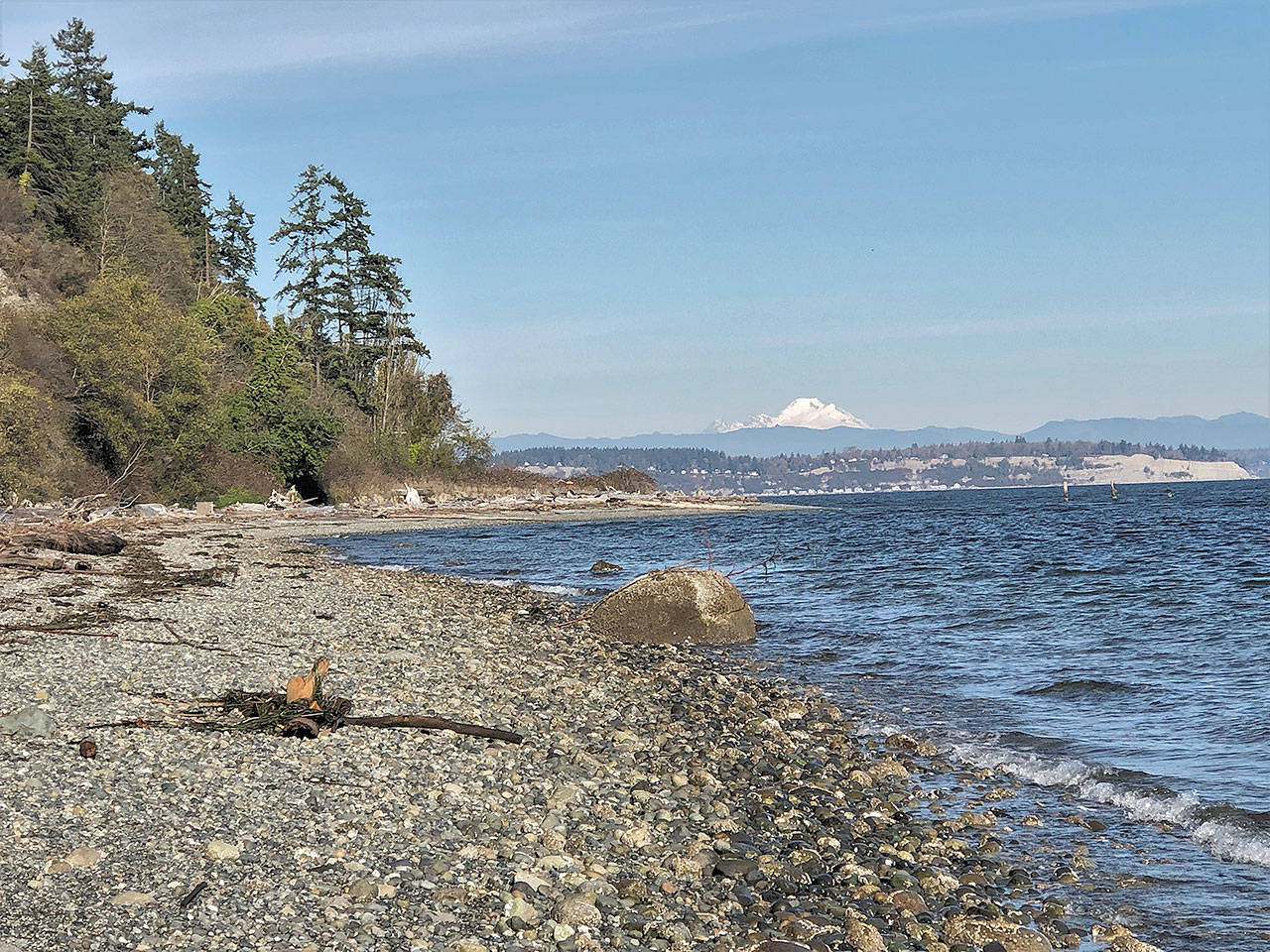By RON NEWBERRY
Special to the Record
As you step from the forested hillside onto the beach, you immediately become aware of how isolated it seems. All you hear is the quiet lapping of waves. All you see in either direction is a long expanse of beach, backed by feeder bluffs topped with mature evergreen trees. On a clear day, you can see Mount Baker in the distance.
“A walk along that shoreline is like a walk back in time,” Dan Matlock said. It’s the sort of place where an afternoon stroll on the beach offers solace and peace.
The 54-acre Possession Sound Preserve is the Whidbey Camano Land Trust’s newest nature preserve. South of Clinton on Whidbey Island, it has more than a half mile of beach previously off limits to the public. Matlock, a retired biology professor and Land Trust board member, has visited the property many times. He joins a long list of people wowed by its natural beauty and vital role in the ecology of the Salish Sea.
“Among its features that are especially valuable are the natural, untouched half-mile stretch of classic Puget Sound feeder bluff and beach with its natural drift cell sediment transport,” Matlock explained. “This is especially important for forage fish spawning.”
Forage fish, including Pacific herring, smelt and sand lance, are critical food sources for salmon, which migrate along the preserve’s shoreline while traveling to and from the Skagit, Stillaguamish and Snohomish rivers. Salmon are the key food source for the region’s beloved orca whales. Adding even more benefit to the marine ecosystem, eelgrass beds line the preserve’s 2,820 feet of shoreline. Two seasonal streams meander through the mature upland forest and down into Possession Sound.
Permanent protection of the property also will safeguard the stability of the steep and actively eroding 180-foot bluff. The former owner of the property worked for more than 40 years to develop the property for homes, completing a rather precarious road to the beach. Now that same road will be used as a trail so the public can gain access.
“There are so few opportunities to protect long stretches of undeveloped shoreline like this,” said Ryan Elting, Land Trust conservation director. “When you also consider the public access component, it’s a complete winner for people, fish and wildlife.”
The preserve won’t be open for public use until safety issues and visitor improvements can be made. When it does open, the Whidbey Audubon Society is eager to make bird inventories.
“I think people will love to have a public access point there,” said Sharon Gauthier, Whidbey Audubon Society president. “Right there, you can see a lot of the seabirds that come in. It will be a convenient spot for a lot of people to observe birds. It’s going to be a very exciting place.”
Restoration projects will soon be underway. The Land Trust is partnering with the Washington Department of Natural Resources to remove toxic creosote pilings from the property. The Land Trust also will be working with community volunteers to prepare the property for public access.
In a partnership with Island County, the Land Trust secured nearly $2.1 million from four funding grants to secure the property. A salmon recovery grant and an aquatic lands enhancement grant were received from the Washington Recreation and Conservation Office. Also received was a $1 million national coastal wetlands grant from the U.S. Fish and Wildlife Service through the Washington State Department of Ecology. A fourth grant was from the Island County Conservation Futures Fund.
Opening the preserve for public use depends on the Land Trust’s ability to secure adequate funding. This will include securing grants and/or privately raised funds in 2020 so that a parking lot can be constructed before the rainy season. Meanwhile, site clean-up, fencing, signs and safety measures are on the agenda before the opening date.
Once these improvements are made, the trail to the long stretch of beach will provide permanent public access in an under-served area of Whidbey Island. Birding, beachcombing, kayaking, fishing, nature viewing and other low-impact recreation will be allowed at the preserve.
Dan Weber of Clinton is grateful the shoreline preserve is protected. He and his wife, Laurie Carron, live near the property and have walked that stretch of beach frequently over the years.
“You can’t get that feeling of kind of being the last man on earth anywhere,” he said.
The Whidbey Camano Land Trust is a nonprofit nature conservation organization that involves the community in protecting, restoring and appreciating the important natural habitats and resource lands that support the diversity of life on the islands and in the waters of Puget Sound. For more information, visit www.wclt.org, email info@wclt.org or call 360-222-3310.



